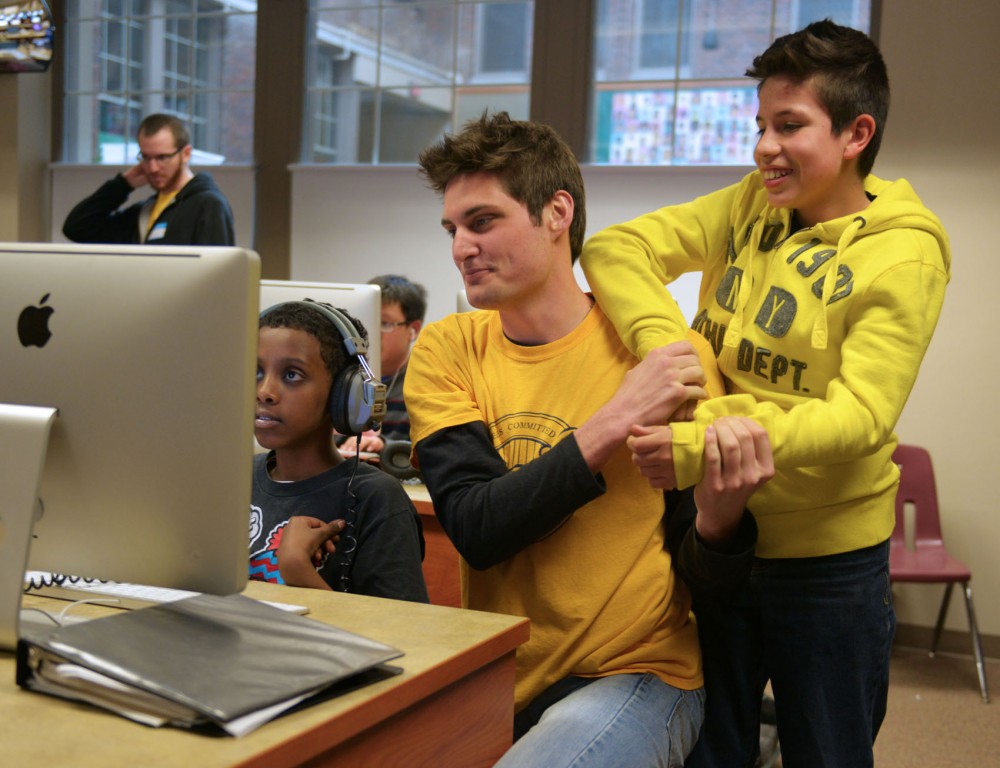Tommy Winter and Julio bonded over sports when they met in February.
The University of Minnesota junior meets the seventh-grader after school twice a week to participate in group activities with other youth as part of the Athletes Committed to Educating Students mentoring program.
Winter said he and Julio have a great relationship, but new numbers show their matchup is a bit of a commodity in the mentoring world.
The Mentoring Partnership of Minnesota found a significant gender gap in mentoring in the state.
Almost twice as many mentors are female than are male, and 29 percent of male youth wait more than a year before being matched with a mentor, according to the study released this year. That’s compared to 5 percent of females.
MPM Executive Director Joellen Gonder-Spacek said there’s a need for more male mentors.
“Men might not feel as competent stepping into a relational role,” she said.
MPM is planning to address the gender gap by reaching out to the University and communicating with men where they hang out, like at football games and barber shops, Gonder-Spacek said. She said they’ll ask current male mentors to talk about mentoring.
Gonder-Spacek said she plans to ask University President Eric Kaler about creating a University-wide mentoring strategy to recruit mentors.
Winter said he hasn’t noticed the gender gap, but said ACES needs more volunteers.
“The more volunteers you get, the more kids you can help,” he said.
Winter learned about the program through a public speaking course that offered volunteering as an alternative to a final exam.
Winter said he likely wouldn’t have joined ACES if the program hadn’t visited his class, and he’ll continue mentoring after the class ends next week.
The sports management student and other mentors play sports with students at Linwood Monroe Arts Plus school in St. Paul and help them with homework, he said.
“You just get the camaraderie with them all day,” he said.
Winter was surprised by how fun mentoring is, he said.
About 70 percent of the programs that took part in the MPM study said a lack of mentors was one of the top three reasons youth are put on a waiting list.
When boys come from single-parent families or don’t have many male figures in their life, a male mentor is often requested, Gonder-Spacek said.
Big Brothers Big Sisters requires youth and mentors to be the same gender.
Kinesiology junior Joe Crosariol said he and his “little brother” have met at Pratt Community School once a week since last fall.
He said they play sports and talk about their week, keeping most of the discussion on the fourth-grader.
Crosariol said the program has helped him learn how to better interact with children.
“I feel like girls are more accepting to the idea of being a role model,” Crosariol said, adding that men may not be ready for that.
Being a “big brother” is a serious role, Crosariol said, “but if you think about it simply, it’s just being a friend.”
Mentor and MPM employee Nicki Patnaude works with Free Arts Minnesota, a weekly program that leads art projects for youth with the Boys and Girls Clubs in St. Paul.
“I see the gender gap every time,” Patnaude said. She said about 70 percent of the mentees are boys.
Patnaude’s team of four women sometimes struggles to relate to the boys they mentor, she said.
Men may be less likely to mentor because they might not fully understand what’s expected of them in that role, Patnaude said.
“It’s really so simple, easy, it doesn’t take much time,” she said.
There are almost 41,000 mentors and more than 196,000 mentees statewide, according to MPM.
Youth are often mentored to keep them engaged in school, Gonder-Spacek said, but it can also affect mental health, she said.
Youth who were mentored for 13 months reported fewer depressive symptoms than youth who didn’t have a mentor, according to a study released this year by the Manpower Demonstration Research Corporation.
“I’m able to be there for my ‘little,’ to be a steady person in her life,” BBBS mentor Morgan Aghjian said.
The family social science sophomore’s “little sister” is 7-year-old Kaylie.
When they make arts and crafts, Aghjian said, Kaylie always wants to trade projects, “so she has mine and I have hers.”
She said she wants to continue mentoring Kaylie while she attends the University.
“After being so close with someone,” Aghjian said, “you don’t want to leave them.”








